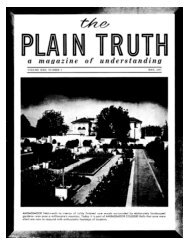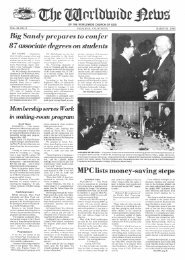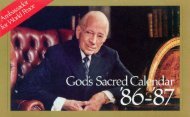The Biblical Basis of the Sacred Calendar Part One
The Biblical Basis of the Sacred Calendar Part One
The Biblical Basis of the Sacred Calendar Part One
Create successful ePaper yourself
Turn your PDF publications into a flip-book with our unique Google optimized e-Paper software.
Thus in every Metonic (19-year or 235-month lunisolar) cycle, twelve years (here, as reckoned from Tishri<br />
1) have but one lunar month during which Passover may be kept, and one lunar month in <strong>the</strong> fall during<br />
which Tabernacles may be kept. Such years are (by definition) common years. <strong>The</strong>y have only twelve<br />
lunar months in <strong>the</strong>m. All o<strong>the</strong>r years are (by definition) intercalary or leap years. <strong>The</strong>y have thirteen lunar<br />
months in <strong>the</strong>m - and are always followed immediately by common years.<br />
What is it <strong>the</strong>n, in principle, that defines a common year in biblical terms (as translated into astronomical<br />
terms)? <strong>The</strong> spring equinox must fall within a given lunar month before <strong>the</strong> calendar day <strong>of</strong> <strong>the</strong> full moon,<br />
or after <strong>the</strong> calendar day <strong>of</strong> <strong>the</strong> full moon within <strong>the</strong> previous lunar month; and <strong>the</strong> fall equinox must fall<br />
before or during (never after) <strong>the</strong> seven-day period beginning with <strong>the</strong> calendar day <strong>of</strong> <strong>the</strong> full moon, six<br />
lunar months (counted inclusively) later. In such years, only one month in <strong>the</strong> spring and one month in <strong>the</strong><br />
fall meet <strong>the</strong> biblical criteria for determining <strong>the</strong> months <strong>of</strong> Abib (Nisan) and Tishri.<br />
During leap years, by contrast, two lunar months in <strong>the</strong> spring, in <strong>the</strong> fall or (rarely) in both <strong>the</strong> spring and<br />
fall22 may fulfill <strong>the</strong> above biblical and astronomical criteria. In all such cases, <strong>the</strong> later <strong>of</strong> any pair <strong>of</strong><br />
months is <strong>the</strong> month that is defined as Abib and/or Tishri. (<strong>The</strong> third seasonal Festival -- Pentecost -- adds<br />
its own control: its date must be reckoned inclusively fifty days after "<strong>the</strong> morrow [within <strong>the</strong> Days <strong>of</strong><br />
Unleavened Bread] after <strong>the</strong> [weekly] Sabbath". It occurs as one approaches ano<strong>the</strong>r milestone in <strong>the</strong><br />
agricultural year: <strong>the</strong> summer solstice.)23<br />
<strong>The</strong> following table illustrates (in part) <strong>the</strong> relationship between <strong>the</strong> lunar months and <strong>the</strong> solar seasons<br />
throughout <strong>the</strong> solar year, and <strong>the</strong> timing <strong>of</strong> "<strong>the</strong> month <strong>of</strong> Abib" and Tabernacles relative to <strong>the</strong>se factors<br />
(all periods are approximate due to graphic limitations):24<br />
In <strong>the</strong> first example row, two months in spring may fulfill a priori <strong>the</strong> biblical conditions for "<strong>the</strong> month <strong>of</strong><br />
Abib". <strong>The</strong> spring equinox occurs in <strong>the</strong> lunar month shaded in light gray. It also occurs just before <strong>the</strong><br />
15th day <strong>of</strong> that month. Should that month be <strong>the</strong> month <strong>of</strong> Abib? No, because six months later (counting<br />
inclusively) Tabernacles would fall wholly in <strong>the</strong> summer. It would indeed fall "(during <strong>the</strong>) turning <strong>of</strong> <strong>the</strong><br />
year", but not "when <strong>the</strong> year goes out". In such a case, <strong>the</strong> year (as reckoned from <strong>the</strong> preceding Tishri<br />
1) is always a leap year. In <strong>the</strong> second example row, <strong>the</strong> fall equinox occurs during Tabernacles; in <strong>the</strong><br />
third example row, before it. In both cases, <strong>the</strong> spring equinox falls within (i.e., on or after <strong>the</strong> first day <strong>of</strong>)<br />
"<strong>the</strong> month <strong>of</strong> Abib". Such years (again, as reckoned from <strong>the</strong> preceding Tishri 1 in all cases) are by<br />
definition common years.<br />
Thus within <strong>the</strong> Metonic cycle, <strong>the</strong>re is a regular sequence <strong>of</strong> common and leap years, which shifts<br />
against <strong>the</strong> solar seasons over <strong>the</strong> centuries.25 <strong>The</strong>re are o<strong>the</strong>r lunisolar cycles available to calendar<br />
makers (such as <strong>the</strong> 11-year Babylonian and 18-year Greek Saros cycles), and leap year sequences<br />
o<strong>the</strong>r than those used historically in <strong>the</strong> Hebrew calendar. No alternatives, though, are as suitable for<br />
keeping <strong>the</strong> Festivals aligned with <strong>the</strong> seasons. However, no regular sequence <strong>of</strong> leap years in a 19-year<br />
cycle can keep <strong>the</strong> sabbatical year from falling in a leap year from time to time, whe<strong>the</strong>r <strong>the</strong> Jubilee cycle<br />
is observed or not.26<br />
Note that three 19-year cycles (57 years) equal one 50-year Jubilee cycle plus one 7-year Land Sabbath
















